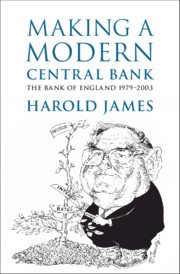Book contents
- Making a Modern Central Bank
- Studies in Macroeconomic History
- Making a Modern Central Bank
- Copyright page
- Dedication
- Contents
- Figures
- Tables
- Acknowledgements
- Abbreviations
- 1 Introductory
- 2 Foreign Fetters
- 3 The Performance of the UK Economy
- 4 The Inexplicable in Pursuit of the Uncontrollable
- 5 ‘A Good Deal of Advice’
- 6 The Long Shadow of the Deutschemark
- 7 Hong Kong
- 8 Shaved Eyebrows
- 9 Tunnelling Deep
- 10 Great Leap in the Dark
- 11 The Spine Theory and Its Collapse
- 12 ‘You Can’t Be In and Out at the Same Time’:
- 13 Horses for Courses
- 14 Failure of Internal Communication
- 15 The New Bank
- 16 Epilogue
- Book part
- Notes
- Bibliography
- Index
5 - ‘A Good Deal of Advice’
The Battle over Policy Control
Published online by Cambridge University Press: 18 September 2020
- Making a Modern Central Bank
- Studies in Macroeconomic History
- Making a Modern Central Bank
- Copyright page
- Dedication
- Contents
- Figures
- Tables
- Acknowledgements
- Abbreviations
- 1 Introductory
- 2 Foreign Fetters
- 3 The Performance of the UK Economy
- 4 The Inexplicable in Pursuit of the Uncontrollable
- 5 ‘A Good Deal of Advice’
- 6 The Long Shadow of the Deutschemark
- 7 Hong Kong
- 8 Shaved Eyebrows
- 9 Tunnelling Deep
- 10 Great Leap in the Dark
- 11 The Spine Theory and Its Collapse
- 12 ‘You Can’t Be In and Out at the Same Time’:
- 13 Horses for Courses
- 14 Failure of Internal Communication
- 15 The New Bank
- 16 Epilogue
- Book part
- Notes
- Bibliography
- Index
Summary
In practice, the early 1980s UK policy involved sporadically – but surprisingly often – responding to exchange rate movements, even when the exchange rate was specifically not designated as either a policy goal or an instrument, as well as raising interest rates as a way to cool down inflation but also economic growth. The 1981 budget, the most controversial of the Thatcher years, was accompanied by the attempt to take the pressure off manufacturing industry by lowering interest rates. The Bank responded to a surge in broad monetary aggregates by overfunding, that is, selling more than the amount of long-term debt (mainly gilts and National Savings instruments) required to finance the government. In 1983, a new Governor, Robin Leigh-Pemberton, who seemed more aligned with Thatcher’s view, came to the Bank of England, replacing Gordon Richardson, whose relationship with the Prime Minister had been strained. In the same year, a new Chancellor the Exchequer, Nigel Lawson, began a slow move away from monetarism and the application of monetary targets. The exchange rate came to play an increasing role in policy.
Keywords
- Type
- Chapter
- Information
- Making a Modern Central BankThe Bank of England 1979–2003, pp. 78 - 146Publisher: Cambridge University PressPrint publication year: 2020

